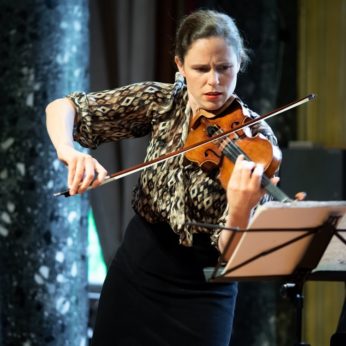Composer: Béla Bartók (b. 1881 - d. 1945)
Performance date: 24/06/2023
Venue: Bantry House
Composition Year: 1944
Duration: 00:30:35
Recording Engineer: Tom Norton, RTÉ
Instrumentation: vn
Instrumentation Category:Solo
Artists:
Nurit Stark -
[violin]

Sonata for Solo Violin Sz.117 [1944]
Bartók died of leukaemia in New York in September 1945. He left the Third Piano Concerto and the Viola Concerto unfinished and he was preparing sketches for a Seventh Quartet and wanted to write a new choral work and orchestrate the Romanian Folk Dances. But despite this late surge of creativity, this Solo Sonata, commissioned by Yehudi Menuhin in 1943, is his last completed work. Menuhin had visited Bartók in New York in order to play through the First Violin Sonata and Bartók had been sufficiently impressed to accept the violinist’s commission.
It is a hugely demanding work for the soloist. The monstrous technical demands of the Chaconne and the four-part Fugue are only the beginning. The secret of the slow movement is the ability to play a whispered pianissimo at the extremities of the violin’s range. However it is not just a technical tour de force but a work of concentrated emotional and intellectual impact, totally unlike his previous composition, the Concerto for Orchestra.
It is above all an act of homage to Johann Sebastian Bach. The opening chords ring out with all the confidence of Bach’s own chaconne and the dance form of the Master is unfolded with all the intellectual rigour at the command of his twentieth century successor. We find here in this magnificent movement both understanding and power and even tenderness; Bach as understood by Bartók and reinterpreted for us. The magisterial Fugue is not built on the same enormous scale as the Chaconne though the four parts give it a massive sonority as a contrast to the intimacy and inwardness of the slow movement. There is a sense of inner peace in this movement quite unlike the crippling sorrow of the Sixth Quartet, written four years earlier. The Melodia returns us to Hungary, his lost homeland, but clear-eyed and with great love. The Finale’s perpetual motion continues in the same hushed pianissimo, before shouting out the joyous dance theme with which he loved to conclude his works.
Francis Humphrys
Copyright © 2025 West Cork Music. All rights reserved.
Designed and developed by Matrix Internet